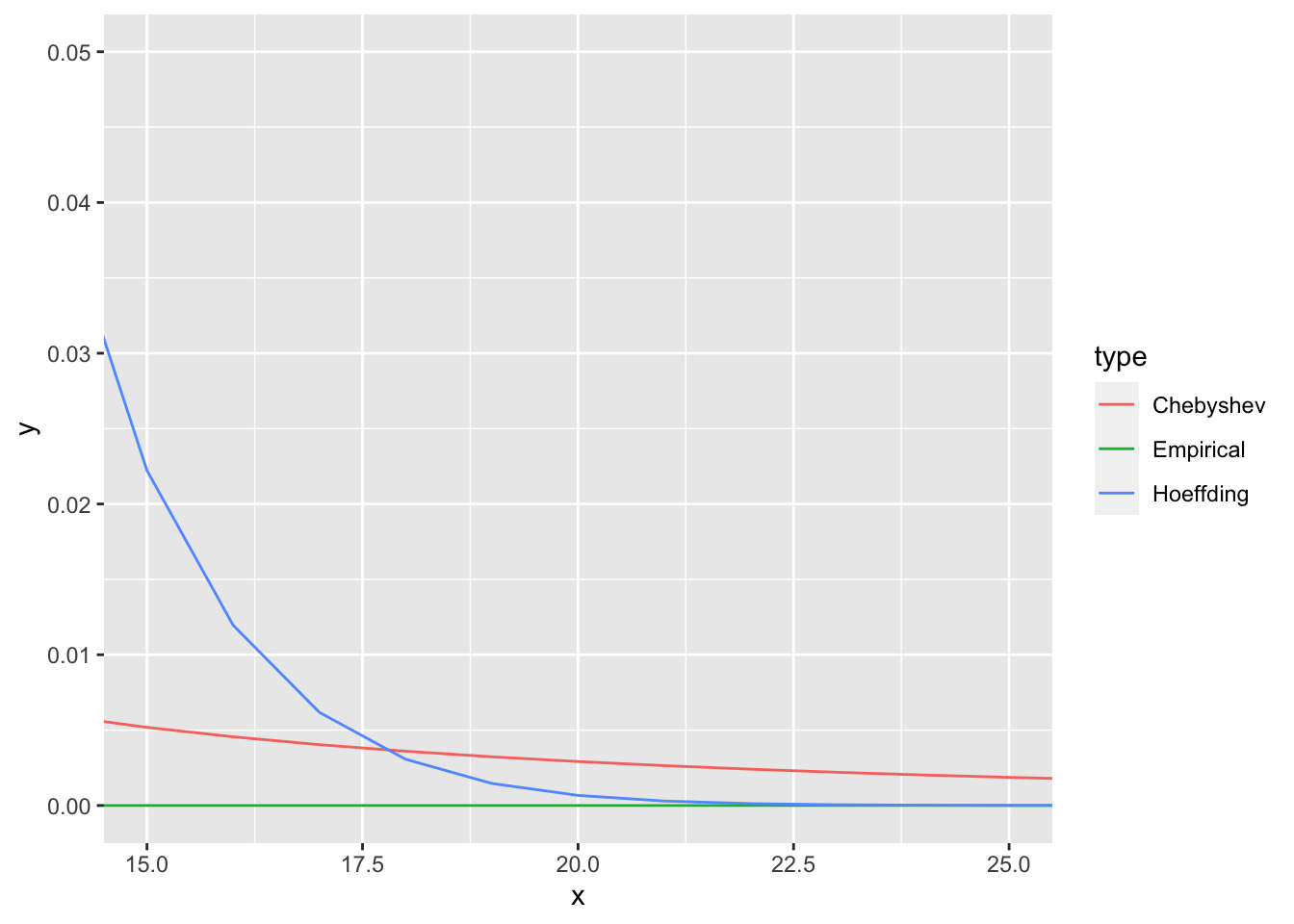Chapter 10 Concentration inequalities
This chapter deals with concentration inequalities.
The students are expected to acquire the following knowledge:
Theoretical
- More assumptions produce closer bounds.
R
- Optimization.
- Estimating probability inequalities.
10.1 Comparison
Exercise 10.1 R: Let \(X\) be geometric random variable with \(p = 0.7\). Visually compare the Markov bound, Chernoff bound, and the theoretical probabilities for \(x = 1,...,12\). To get the best fitting Chernoff bound, you will need to optimize the bound depending on \(t\). Use either analytical or numerical optimization.
bound_chernoff <- function (t, p, a) {
return ((p / (1 - exp(t) + p * exp(t))) / exp(a * t))
}
set.seed(1)
p <- 0.7
a <- seq(1, 12, by = 1)
ci_markov <- (1 - p) / p / a
t <- vector(mode = "numeric", length = length(a))
for (i in 1:length(t)) {
t[i] <- optimize(bound_chernoff, interval = c(0, log(1 / (1 - p))), p = p, a = a[i])$minimum
}
t## [1] 0.5108267 0.7984981 0.9162927 0.9808238 1.0216635 1.0498233 1.0704327
## [8] 1.0861944 1.0986159 1.1086800 1.1169653 1.1239426ci_chernoff <- (p / (1 - exp(t) + p * exp(t))) / exp(a * t)
actual <- 1 - pgeom(a, 0.7)
plot_df <- rbind(
data.frame(x = a, y = ci_markov, type = "Markov"),
data.frame(x = a, y = ci_chernoff, type = "Chernoff"),
data.frame(x = a, y = actual, type = "Actual")
)
ggplot(plot_df, aes(x = x, y = y, color = type)) +
geom_line()
Exercise 10.2 R: Let \(X\) be a sum of 100 Beta distributions with random parameters. Take 1000 samples and plot the Chebyshev bound, Hoeffding bound, and the empirical probabilities.
set.seed(1)
nvars <- 100
nsamps <- 1000
samps <- matrix(data = NA, nrow = nsamps, ncol = nvars)
Sn_mean <- 0
Sn_var <- 0
for (i in 1:nvars) {
alpha1 <- rgamma(1, 10, 1)
beta1 <- rgamma(1, 10, 1)
X <- rbeta(nsamps, alpha1, beta1)
Sn_mean <- Sn_mean + alpha1 / (alpha1 + beta1)
Sn_var <- Sn_var +
alpha1 * beta1 / ((alpha1 + beta1)^2 * (alpha1 + beta1 + 1))
samps[ ,i] <- X
}
mean(apply(samps, 1, sum))## [1] 51.12511## [1] 51.15723## [1] 1.170652## [1] 1.166183a <- 1:30
b <- a / sqrt(Sn_var)
ci_chebyshev <- 1 / b^2
ci_hoeffding <- 2 * exp(- 2 * a^2 / nvars)
empirical <- NULL
for (i in 1:length(a)) {
empirical[i] <- sum(abs((apply(samps, 1, sum)) - Sn_mean) >= a[i])/ nsamps
}
plot_df <- rbind(
data.frame(x = a, y = ci_chebyshev, type = "Chebyshev"),
data.frame(x = a, y = ci_hoeffding, type = "Hoeffding"),
data.frame(x = a, y = empirical, type = "Empirical")
)
ggplot(plot_df, aes(x = x, y = y, color = type)) +
geom_line()
ggplot(plot_df, aes(x = x, y = y, color = type)) +
geom_line() +
coord_cartesian(xlim = c(15, 25), ylim = c(0, 0.05))
10.2 Practical
Exercise 10.3 From Jagannathan. Let \(X_i\), \(i = 1,...n\), be a random sample of size \(n\) of a random variable \(X\). Let \(X\) have mean \(\mu\) and variance \(\sigma^2\). Find the size of the sample \(n\) required so that the probability that the difference between sample mean and true mean is smaller than \(\frac{\sigma}{10}\) is at least 0.95. Hint: Derive a version of the Chebyshev inequality for \(P(|X - \mu| \geq a)\) using Markov inequality.
Solution. Let \(\bar{X} = \sum_{i=1}^n X_i\). Then \(E[\bar{X}] = \mu\) and \(Var[\bar{X}] = \frac{\sigma^2}{n}\). Let us first derive another representation of Chebyshev inequality. \[\begin{align} P(|X - \mu| \geq a) = P(|X - \mu|^2 \geq a^2) \leq \frac{E[|X - \mu|^2]}{a^2} = \frac{Var[X]}{a^2}. \end{align}\] Let us use that on our sampling distribution: \[\begin{align} P(|\bar{X} - \mu| \geq \frac{\sigma}{10}) \leq \frac{100 Var[\bar{X}]}{\sigma^2} = \frac{100 Var[X]}{n \sigma^2} = \frac{100}{n}. \end{align}\] We are interested in the difference being smaller, therefore \[\begin{align} P(|\bar{X} - \mu| < \frac{\sigma}{10}) = 1 - P(|\bar{X} - \mu| \geq \frac{\sigma}{10}) \geq 1 - \frac{100}{n} \geq 0.95. \end{align}\] It follows that we need a sample size of \(n \geq \frac{100}{0.05} = 2000\).